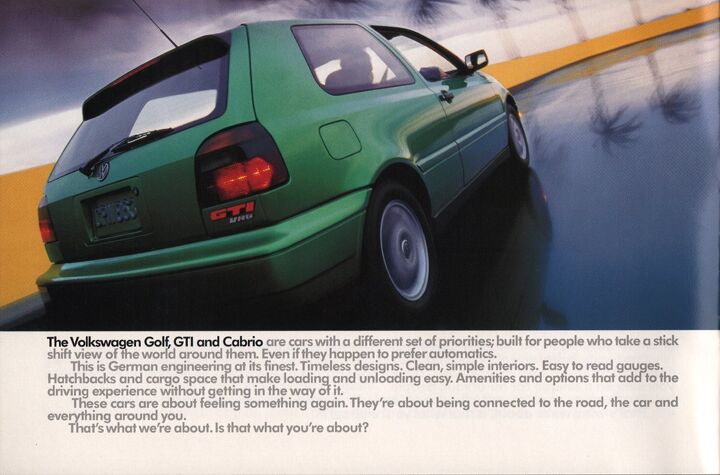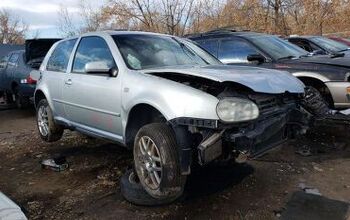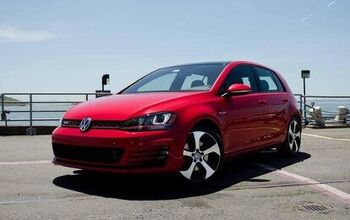Capsule Review: 1995 Volkswagen GTI VR6

All the stereotyping of Germans as uncompromising people dedicated to engineering ideals and whatnot aside, it’s slightly terrifying to see how willing the automakers of the Fatherland have been to adjust their product and presentation to fit customer misconceptions. Example Zero: The “E” at the end of Mercedes model designators like “280E” meant Einspritz. Fuel injection. This was meant to distinguish Benzos with injection from the sad-sack 230 and 250 models, which despite costing as much as a house in a decent neighborhood failed to ingest their fuel under any pressure beyond that of gravity.
This makes perfect sense, but to Americans who never saw the carbed models in showrooms, “E” came to mean mid-size. Like 300E, 500E. The proper response to this blithe country-club idiocy would have been to complete the Amerika Bomber and to use it to saturate America’s upper middle class with leaflets and/or cluster munitions, whatever worked better to drive the correct usage home. Instead, however, the men of Mercedes-Benz simply decided to create the “E-Class”, which is why the automobile that should be known as a 460E TURBO is currently mis-badged “E550”. What a disgrace.
Example One: the worst GTI in history.
The reasons that VW failed to keep its costs and pricing under control could fill a book and range from currency fluctuation to the outrageous adventures of TTAC’s previous Editor-In-Chief, but the bottom line was that by the time the Nineties rolled around, a Volkswagen was a premium product by virtue of pricing. I should know: I bought a Brazilian-built Fox with a sticker price of $10,200 in 1990, when a Tercel EZ sold for $6995. Even with production subcontracted to borderline Third World countries like Brazil and Mexico, VW couldn’t manage to match the price of Japanese competitors.
Those of us who purchased Volkswagens liked to believe that we were buying Autobahn-ready panzerwagens of unprecedented sophistication despite the obvious evidence of four-speed transmissions, CIS fuel injection, and half-lives comparable to that of fermium-257. Back then, Dr. Karl Benz had yet to invent the CLA250, so proles with low bank balances who wanted the distinctive smell of German plastic had no choice but to be funneled into VW dealerships like cattle in a Chicago slaughterhouse. The prices kept going up, but as long as they were below the ask for, say, a 318is, we continued to buy, and sometimes the dealership threw in a “fahrvergnügen” T-shirt.
The Mk1 and Mk2 Golfs were far from luxury goods, but even as the third-generation model was in the planning stages it was grimly obvious that not even building the things in Puebla, where the average wage wouldn’t keep a Tijuana donkey in feed, could keep them from being priced as the Patek Philippes of compact cars. Nor was it possible, or even desirable, to reset Americans’ idea of the Volkswagen brand from “German car” back down to “cheap car”. It was decided, therefore, to make the Mk3 Golf a premium vehicle, and the Mk3 GTI even more of one.
The first thought you’ll have when you sit in the 1995 Golf, having recently sat in its predecessors, is this: they changed all the hardware. Prior to 1994, most water-cooled VWs felt about the same to the touch. From the Dasher to the Quantum to the Rabbit to the Scirocco, they had the same trigger-pull door handles, the same steering wheels, the same switchgear, the same instruments, the same smell, the same mouse-fur on the seats, the same plastics. The third-generation Passat, the first to be called “Passat” in the United States, had a significantly upgraded interior, with all-new touch points, and the Mk3 shared many of those. All of a sudden, you’re in a modern Volkswagen: thick doors, thick pillars, a dash that bends around you, and the earliest forms of the infamous VW soft-touch plastic that feels like a million dollars and wears like paper-mache.
The interior in the 1995 GTI that VWoA has provided for me to drive hasn’t held up nearly as well as that of the beat-up Mk2 that I’d driven immediately beforehand. It’s faded, cracking, revealing colorless alien flesh behind the thin black epidermis of the door rests and various switches. The plastic key feels fragile, but twisting it brings the mighty two-valve VR6 awake. Oooh.
What’s a VR6? It’s a 15-degree narrow-angle V6 designed to fit where a four-cylinder fits. It sounds frankly magnificent and as I pull away from the rest of the forlorn “heritage” GTIs on display, the torque is immediately present and fully accounted for. After the wheezing 16v, this feels like a big-block Corvette. Which was the intention at the time: VW knew the new car would be yet again heavier than its predecessor and decided to address the problem with cubic inches.
In no time, the VR6 GTI is sprinting for the first right-hand turn, where it all falls apart. The old cars had balance but no grip; this has a small amount of grip but the balance is miserable and it heels over like it’s in the America’s Cup. And there’s torque steer in spades, yanking me off-line with no inconsiderable strength. Surely ninety percent of the weight in this car is over the front wheels. (It’s actually 64/36.) Best to straighten out the front wheels and just revel in the torque and the rush to the low redline, accompanied by that unmistakable snarl.
From the advertising of the time, you get the sense that VW was aiming the GTI at the E36 325i. That may be, but they missed that car and hit the E39 540i instead. It’s big, comfy, with great seats, and it grunts out of every corner after grumbling all the way through it. It’s not really a GTI, and no wonder: the oh-so-superior Europeans got a 150-hp four-cylinder GTI. Overseas, this car was known simply as “VR6”, not GTI.
I’m hugely fond of the car immediately, but remember, I’m the moron who used to have two Phaetons. The idea of a luxury Volkswagen doesn’t shock me. And that’s what this is, really: the most luxurious and powerful version possible of a compact car that has lost any pretense of being an “economy car”. It makes brilliant sense for the way Americans really drive their cars; it’s at home on a freeway or sprinting from stoplight to stoplight. On a twisty back road it would be a mess but hey — when this car was new, original Rabbit GTIs were a dime a dozen in the classifieds and you could have had one of those for less than the cost of the VR6 upgrade from a standard “2.slow” liter Golf. At 2800-plus pounds, it’s nearly as heavy as the current GTI but somehow it manages to feel like it weighs more.
Having delivered a GTI that actually felt and drove like the premium item the Monroney indicated, VW must have felt bewildered when it failed to receive positive opinions from the critics or the buyers. Nearly all the reviews complained about the suspension and refused to acknowledge the car as a true GTI. (Attentive readers will notice that, by the time, the GTI had been getting negative reviews for nine of its eleven years in the United States.) Still, 1993 would up being the absolute nadir of Volkswagen sales in the country. The Mk3 reversed the tide, although it was $199/month teal “Jetta ///”s that did the trick, not high-dollar GTI VR6es.
The stage was set for VW to push even further upmarket, a push given a push of its own by the arrival of Imperial Leader Piech on the scene in 1993. The next Golf would be a masterpiece of sorts, making this Mk3 the most forgettable of all. Unless, that is, you have a straight road ahead and the windows down.
(Disclosure: VWoA provided transportation and accommodation for this event, said accommodation being willfully misused by this author for the purpose of enjoying the company of a single mother from New Mexico, leading him to arrive late for the morning briefing and earning him the “stink-eye” from at least two journosaurs.)

More by Jack Baruth
Latest Car Reviews
Read moreLatest Product Reviews
Read moreRecent Comments
- Rishabh Ive actually seen the one unit you mentioned, driving around in gurugram once. And thats why i got curious to know more about how many they sold. Seems like i saw the only one!
- Amy I owned this exact car from 16 until 19 (1990 to 1993) I miss this car immensely and am on the search to own it again, although it looks like my search may be in vane. It was affectionatly dubbed, " The Dragon Wagon," and hauled many a teenager around the city of Charlotte, NC. For me, it was dependable and trustworthy. I was able to do much of the maintenance myself until I was struck by lightning and a month later the battery exploded. My parents did have the entire electrical system redone and he was back to new. I hope to find one in the near future and make it my every day driver. I'm a dreamer.
- Jeff Overall I prefer the 59 GM cars to the 58s because of less chrome but I have a new appreciation of the 58 Cadillac Eldorados after reading this series. I use to not like the 58 Eldorados but I now don't mind them. Overall I prefer the 55-57s GMs over most of the 58-60s GMs. For the most part I like the 61 GMs. Chryslers I like the 57 and 58s. Fords I liked the 55 thru 57s but the 58s and 59s not as much with the exception of Mercury which I for the most part like all those. As the 60s progressed the tail fins started to go away and the amount of chrome was reduced. More understated.
- Theflyersfan Nissan could have the best auto lineup of any carmaker (they don't), but until they improve one major issue, the best cars out there won't matter. That is the dealership experience. Year after year in multiple customer service surveys from groups like JD Power and CR, Nissan frequency scrapes the bottom. Personally, I really like the never seen new Z, but after having several truly awful Nissan dealer experiences, my shadow will never darken a Nissan showroom. I'm painting with broad strokes here, but maybe it is so ingrained in their culture to try to take advantage of people who might not be savvy enough in the buying experience that they by default treat everyone like idiots and saps. All of this has to be frustrating to Nissan HQ as they are improving their lineup but their dealers drag them down.
- SPPPP I am actually a pretty big Alfa fan ... and that is why I hate this car.




































Comments
Join the conversation
I had a '98 'Driver's Edition' GTI VR6. Owned for 9 years 247,000 miles. To sum it up: great powertrain in a not-so-great chassis (I did add Eibach springs - which totally transformed the car).
"The “E” at the end of Mercedes model designators like “280E” meant Einspritz. Fuel injection. This was meant to distinguish Benzos with injection from the sad-sack 230 and 250 models, which despite costing as much as a house in a decent neighborhood failed to ingest their fuel under any pressure beyond that of gravity." Surely you mean 'atmosphere' not 'gravity'